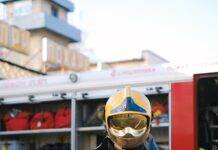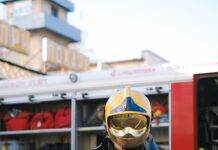
What is the Life of a Fire Sprinkler?
What is the Life of a Fire Sprinkler? : Fire is a formidable force, capable of devastating properties and claiming lives in a matter of minutes. To combat this ever-present threat, we rely on a hidden savior – fire sprinklers. These unassuming devices are strategically placed in buildings to douse flames with a life-saving shower of water. But have you ever wondered about the life of a fire sprinkler? How do they work, and what keeps them operational for years? In this article, we’ll delve into the fascinating world of fire sprinklers, exploring their mechanisms, lifespan, and importance.
How Do Fire Sprinklers Work?
Activation Mechanism
Fire sprinklers are equipped with a heat-sensitive element that responds to elevated temperatures. When a fire starts, the air surrounding the sprinkler becomes hot, causing the element to activate. This, in turn, releases a valve, allowing pressurized water to flow through the sprinkler head and into the affected area.
Water Supply System
A reliable source of water is crucial for fire sprinklers to function effectively. They are typically connected to the building’s water supply or a dedicated fire protection system. The water is stored at a predetermined pressure, ready to be unleashed in case of a fire.
Heat Detection
The heat-sensitive element in a fire sprinkler is calibrated to activate at a specific temperature. This ensures that the sprinkler only activates when there is a genuine fire, preventing false alarms.
Types of Fire Sprinklers
There are various types of fire sprinkler systems, each designed for specific environments and fire hazards:
Wet Pipe Systems
In wet pipe systems, water is constantly present in the pipes, ready for immediate release when the sprinkler activates. They are commonly used in areas where freezing is not a concern.
Dry Pipe Systems
Dry pipe systems use pressurized air or nitrogen in the pipes. When a sprinkler activates, the gas is released, allowing water to flow into the pipes and onto the fire. These systems are ideal for areas at risk of freezing.
Deluge Systems
Deluge systems are designed for high-hazard areas. They release a large volume of water simultaneously when the system detects a fire.
Pre-Action Systems
Pre-action systems are a combination of dry and wet systems, and they are commonly used in environments where accidental activation could be costly, such as data centers and art galleries.
The Life of a Fire Sprinkler
Durability and Maintenance
Fire sprinklers are engineered for durability and longevity. With proper maintenance, they can last for decades. Routine inspections, testing, and maintenance are essential to ensure they remain in working condition.
Factors Affecting Lifespan
The lifespan of a fire sprinkler can be influenced by several factors, including the quality of the system, the environment it operates in, and the regularity of maintenance. High-quality systems in a controlled environment tend to have a longer life.
Replacing Old Sprinklers
In some cases, older fire sprinklers may need to be replaced with more modern and efficient models. This is often done to improve fire protection and reduce the risk of system failure.
Fire Sprinklers in Action
Fire sprinklers have proven to be invaluable in protecting lives and property:
Swift Response to Fires
Fire sprinklers are designed to respond rapidly to a fire, containing it before it has a chance to escalate. This quick action significantly reduces the spread of flames and smoke.
Minimizing Fire Damage
By controlling and extinguishing fires in their early stages, sprinklers prevent extensive damage to the building and its contents, reducing the financial impact of fires.
Saving Lives
The primary objective of fire sprinklers is to save lives. Their ability to control and suppress fires allows occupants to escape safely and provides valuable time for firefighters to arrive on the scene.
Importance of Regular Inspections
Regular inspections and maintenance are critical to ensure fire sprinklers function as intended. These measures help identify and rectify any issues that may compromise the system’s reliability.
Detecting and Preventing Failures
Regular inspections can identify potential problems, such as clogged nozzles, damaged pipes, or faulty activation mechanisms. Addressing these issues promptly is essential for the system’s effectiveness.
Ensuring Optimal Functionality
Scheduled maintenance, such as cleaning nozzles and testing valves, keeps the system in optimal condition, ready to respond to any fire emergency.
Environmental Impact
While fire sprinklers are essential for fire safety, they do have environmental implications:
Water Consumption
The large volume of water used in fire sprinkler systems can be a concern in arid regions. However, it’s a necessary trade-off to safeguard lives and property.
Eco-Friendly Alternatives
Some buildings opt for alternative fire suppression methods, such as gas-based systems, to reduce water consumption. However, these alternatives come with their own set of challenges and considerations.
Regulations and Compliance
To ensure the effectiveness of fire sprinkler systems, there are regulations and compliance standards in place:
Building Codes and Standards
Building codes and standards dictate the installation and maintenance requirements for fire sprinkler systems. Compliance is mandatory to ensure safety.
Annual Inspections
Annual inspections by certified professionals are typically required to ensure the continued functionality of fire sprinklers.
Legal Consequences of Non-Compliance
Non-compliance with fire safety regulations can result in legal consequences, including fines and penalties, not to mention increased risks in the event of a fire.
Conclusion
In the realm of fire safety, fire sprinklers stand as unsung heroes, tirelessly protecting lives and property. Their mechanisms are ingeniously designed to respond swiftly to the threat of fire, minimizing damage and saving lives. The lifespan of a fire sprinkler is a testament to its engineering, and with proper maintenance, it can serve its purpose for many years. Environmental concerns are balanced with the need for safety, and regulations ensure their effectiveness. Remember, the life of a fire sprinkler is a life-saving one.
What is K-Factor in Sprinkler Systems?
Where Are Fire Sprinkler Systems Used?
What is the Use of Fire Sprinklers?
Unique FAQs
- How long do fire sprinklers last before needing replacement?
- The lifespan of a fire sprinkler depends on various factors, but with proper maintenance, they can last for several decades.
- Do fire sprinklers work in freezing temperatures?
- Yes, dry pipe fire sprinkler systems are designed to work effectively in freezing conditions by preventing water from freezing in the pipes until a fire activates the system.
- Can I install fire sprinklers in my home?
- Yes, it’s possible to install fire sprinklers in residential buildings to enhance safety.
- Are there alternatives to water-based fire sprinkler systems?
- Yes, there are alternative fire suppression systems, such as gas-based systems, but they come with their own considerations and challenges.
- What are the common causes of false alarms in fire sprinkler systems?
- Common causes of false alarms include dust or debris blocking the sprinkler head, accidental damage, or mechanical failures, underscoring the importance of regular inspections and maintenance.





















